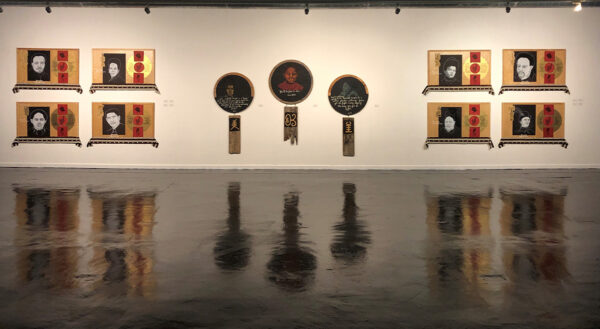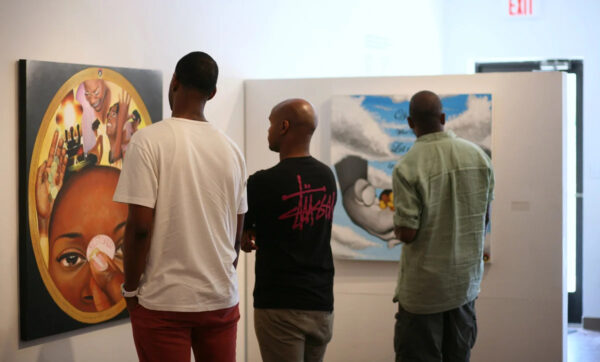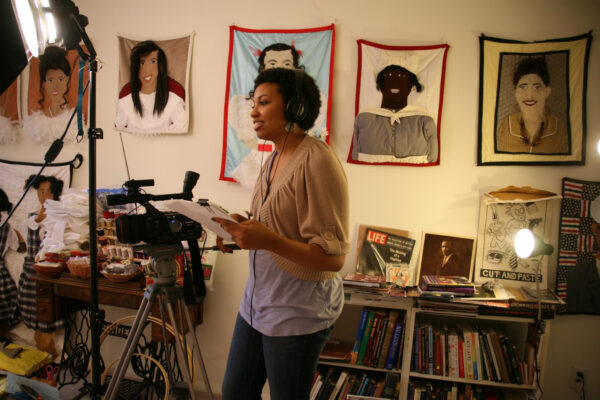Last month, Lauren Cross left her position as Assistant Professor and Program Coordinator of Interdisciplinary Art and Design Studies at the University of North Texas to become the Gail-Oxford Associate Curator of American Decorative Arts at The Huntington Library, Art Museum, and Botanical Gardens in San Marino, California. About one month into her new position, Cross spoke with me about her time in Texas and her plans for the future.
Jessica Fuentes (JF): You were born in Houston and spent time studying outside of Texas while pursuing some of your higher education degrees. What drew you back to Texas in your early career, and why North Texas specifically?
Lauren Cross (LC): Family and professional opportunities. My husband and I had been living in Boston for a few years and both earned our Master’s degrees there. Then we moved to Texas after my husband was offered a position at a community college and I was accepted into the doctoral program at Texas Woman’s University. We were really excited to come home and be closer to our family. We both had been away for some time, and prior to Boston I had been in London studying there for a few years. So I think we both saw Texas through a new lens.
In terms of North Texas, I had spent a lot of time in the Dallas/Fort Worth area when I studied at the University of Texas Arlington. Ultimately, we both really liked North Texas, Fort Worth specifically, and spoke of fond memories during our youth spending time there, so it was a really familiar place for us.
JF: While much of your curatorial career, especially early on, has focused on the North Texas area, you also worked across the state. What takeaways do you have about the different cities or regions in Texas? Did you see any larger trends in the various art scenes? Did you have a favorite city or region?
LC: San Antonio has always been a really welcoming city for me and really holds a special place in my heart, both for my curatorial and art practice.
I met Aissatou Sidime-Blanton, curator and collector, and Riley Robinson, Director at Artpace San Antonio years ago when I started WoCA (Women of Color in the Arts) Projects, and they both were very supportive of me early on as an artist and curator. I also felt really connected to the history and culture of the arts community there. It seemed that my interests as a curator to diversify the landscape were in sync with the mindset there way before it became popular to do so, and I felt welcomed with open arms.
I can also say that I have felt really supported in North Texas as well, but it just felt really special to connect with an arts community outside of one’s personal community where there was so much solidarity with the work I was doing early on in my career. I have heard similar things from other curators and artists of color in terms of diversity in the arts, and I think it is because San Antonio and Houston have always had artists that really active in their communities, from city arts funding to local arts organizations. I had the opportunity to serve on public art panels there, and later went on to curate the International Artist-in-Residence Program for Artpace in Fall 2020. Then in Spring 2022, I curated Contemporary Arts Month San Antonio.
In Fall 2019, I was honored to curate Vicki Meek’s retrospective at the Houston Museum of African American Culture, which felt like coming home. Vicki’s retrospective was such an awesome opportunity and was in many ways a celebration of her work in a city that really honored her. It was a full circle moment because so much of who I am as an artist and curator comes from being raised in the Houston arts community and seeing the strength of it up close and personal. From Project Row Houses, Community Artist Collective, and Shape Center to the Ensemble Theatre, those were the arts institutions that taught me art could be a vehicle to serve your community.
So I cannot really say that I have a favorite city necessarily, but I definitely like different things about each city. North Texas has been home for well over a decade, so I would say that it is particularly special to me, and I am really proud of all the progress that the city of Fort Worth has made.
JF: You created WoCA Projects in 2012. What goals did you set for the organization when you first established it? What goals did you set for yourself as an emerging curator?
LC: WoCA Projects really emerged as a result of my experiences as a woman artist of color myself and realizing that there were few places to really see the intersections between women and men artists across racial and ethnic backgrounds in gallery and museum spaces. I wanted to build on the history and legacy of curators and scholars who championed women artists of color in the past, and create a space that would allow artists to feel free to explore and experiment. I wanted to create opportunities for artists to think about the communities they wanted to serve and partner with them to find ways to speak and connect with those communities.
I was inspired by the work of women of color feminist and womanist artists of the late ‘70s, who challenged the women’s movement for their racism and wanted to create more intentional spaces for women artists of color to be included in art exhibitions in galleries and museums. So it was that history and the legacy of artist-curators like Howardena Pindell, who was one of my artist mentors in graduate school, that really inspired me to think about how I could make an impact on the landscape through curatorial practice.
As a doctoral student at the time who was also thinking transformatively about gender, I was also interested in how interrelated conversations could look across various identities by bringing different artists together who might not all identify with one another, but have common threads in their work. I wanted to see artists in exhibitions together who I felt should be in conversation, like the show Autobiography in 2014, which featured artists from very different backgrounds who were exploring autobiographical themes in their work in very different ways. It was inspired by an exhibition that Pindell did in the late ‘70s by the same title that featured various women artists of different ethnicities and backgrounds. I was interested in taking that idea further by including both women and male artists.
JF: Can you tell me a little about how WoCA Projects shifted over time?
LC: I began with the goal of WoCA Projects as a nonprofit arts project space because I wanted there to be flexibility in the design and the opportunity to collaborate with other curators and community partners on projects. I wanted to create space for things to happen and support other people who had ideas. Ultimately, I felt that in order for the idea to have maximum impact it could not be limited to a brick and mortar space, but it had to start somewhere. I always believed though that the spirit of space could be a model that could happen anywhere, and that was my hope — that WoCA Projects would not be the only place where you could see these kinds of exhibitions happening. I wanted to see diversity in the arts happening everywhere. I wanted to create a catalyst for change.
JF: Do you feel you achieved everything you set out to do with WoCA Projects?
LC: I absolutely feel there is more work to do, but I am happy that I was able to accomplish so much with WoCA Projects. There were many other people in the community who understood what I was trying to accomplish and who believed in the mission. And ultimately, this is something that is not conclusive, so there is always more that can be done. I am excited now that there are more curators of color and project spaces that exist in the community who are continuing the work. I am happy to have played a role, in whatever way I have, in instigating that change. When I think back, I am amazed that we were able to do so much with so little, bringing artists, small organizations, businesses, and emerging leaders together. And while it was heart-breaking for me to have to let go of the brick-and-mortar space in 2015, I discovered so much more about how to do this work in other spaces and the challenge of thinking about how I could bring what I had learned into other platforms.
JF: What are some of your proudest curatorial moments in Texas?
LC: There have been many really amazing moments. I will never forget walking into the grand opening of WoCA Projects in 2013 and being amazed that so many people had come from all over North Texas. I would say that was definitely one of my fondest memories, and then more recently Black Every Day: Photographs from the Carter Collection, which I co-curated with Dr. Kristen Gaylord, Associate Curator of Photographs at the Amon Carter Museum of American Art, because it was an exhibition where I felt the most impact from visitors. And lastly, New Stories, New Futures at Pioneer Tower. It was one of my most public curatorial projects, and probably the most challenging.
JF: Tell me a little about your decision to leave your position at UNT and Texas in general.
LC: Well, my husband got a very exciting position in Pasadena, CA and so that certainly started the momentum, but I think working on Black Every Day with Kristen sparked my interest in pursuing a curatorial position in a museum. I told Kristen that I blame her for being the best co-curator ever and for creating the space for me to think about the ways in which exhibitions can have a direct impact on museum visitors. As someone who has researched about curating and the visitor experience, it was encouraging to see methods put into practice.
JF: What are you most excited about as you look ahead to your future in your new role as Associate Curator of Decorative Arts at The Huntington?
LC: I am really excited to focus on my ongoing research in the field of decorative arts, which centers on African American cultural traditions. I have been researching and writing about African American fiber and quilt traditions since 2009, after directing and producing a documentary called The Skin Quilt Project, which explored skin color politics through the lens of African American quilters. I later co-curated an exhibition entitled The Skin Quilt Project: Uplifting our Culture, Celebrating Tradition to honor the African American quilters I had featured in the film, as well as others who created quilts as a tool to inspire a positive sense of cultural heritage and well-being.
Much of my curatorial practice has been about exploring diverse and forgotten narratives within the material world. So, I am really excited to bring my diverse experiences curating exhibitions that range from decorative arts to contemporary art to my new position at The Huntington, and to play a role in new acquisitions and programming that will not only highlight the works of artists of color, but explore ways to connect these artists with visitors and local communities.
JF: In what ways will you still be involved in the Texas art scene in the near and distant future?
LC: Currently I have a few curatorial projects that are coming up, including the co-curated retrospective for the award-winning Houston artist Floyd Newsum, which will begin at the Madison Museum of Contemporary Art this summer and hopefully make its way to Texas in the future. I am also working with the National Juneteenth Museum in Fort Worth as their Executive Strategist, helping to shape the future of the upcoming museum. Additionally, I am working to connect institutions with other emerging artists and curators in the community who are making important contributions. I am excited to be able to see others rise.






